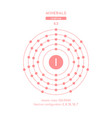

These artificial elements don’t exist naturally and haven’t survived longer than several milliseconds at a time. Scientists created elements 93 through 118 in a laboratory. So, beryllium has four protons and five neutrons.

Nine total protons and neutrons minus four protons leaves you with five neutrons. Beryllium is number four on the periodic table, so it has four protons. Remember that the atomic number tells you how many protons there are. That’s the total number of neutrons and protons combined in the nucleus of a beryllium atom.įrom there, you can find the number of neutrons in an atom by subtracting the total number of protons from the mass number. For example, beryllium’s atomic mass is 9.0112, so you can round it to nine. If you simply want to know an element’s mass number - which doesn’t have a decimal, because it’s the actual number of protons and neutrons in an atom - round the atomic mass to the nearest whole number. That’s why many atomic mass numbers have a decimal. In other words, the number you’re seeing is the element’s average mass, but you might find it at a different mass depending on the number of neutrons it contains. The atomic mass number on the modern periodic table is the weighted average of the atomic masses of that element’s naturally occurring isotopes. Therefore, different isotopes will have different amounts of mass. Just as an ion is an element with more or fewer electrons than usual, an isotope is a version of an element that contains a different number of neutrons. That’s because they sometimes contain different numbers of neutrons. However, even two atoms of the same element might have different weights. If you read the periodic table, you’ll see that oxygen weighs 15.999 u. This number tells you how much a single atom of that element weighs in atomic mass units. The atomic mass is the number usually - but not always - located at the bottom of an element key. That just tells you the number of protons. Therefore, don’t assume how many electrons an element has based on its atomic number on the periodic table. Cations are positively charged, while anions have a negative charge. These positively and negatively charged atoms are called ions. Others have fewer electrons than protons, giving them a positive charge. Some atoms have more electrons than protons, giving them a negative charge. However, this is only sometimes the case. It’s worth noting that most atoms have an equal number of protons and electrons, so the atomic number gives you a hint as to how many electrons an atom contains. Each element has one more proton than the one before it. Not only does it let you count the protons, but it also determines the element’s place on the table. The number of protons in an element cannot change or else it would become a different element entirely!Įvery element on the periodic table has an atomic number assigned to it. Since oxygen is number 8 on the periodic table, that tells you there are eight positive protons in the center of each atom. Atomic NumberĪn element’s atomic number lets you know how many protons are in the nucleus. The element key helps you learn about the individual elements in the periodic table. Lead was the least desirable of the ancient metals due to its dull grey colour and heaviness, so it was associated with Saturn – the furthest of the known planets.Components of an element key. Gold, for example, was associated with the Sun due to its colour and value.

Each metal was associated with one of the seven known celestial bodies. The other metals of antiquity are gold, silver, copper, tin, iron and mercury. Lead is one of the seven metals of antiquity – metals that humans identified and used in ancient times. The soft black substance in your wooden pencil has never been made of lead. Plumbago (also known as black lead) is actually graphite. Today, we call this plumbing and those who work with it plumbers.Ī similar word, plumbago, also has an association with lead and it has caused misconceptions for centuries. The Roman Empire used lead to make waterpipes, so the word plumbum was associated with systems that carried water into buildings. Lead’s chemical symbol – Pb – comes from the Latin word plumbum.


 0 kommentar(er)
0 kommentar(er)
